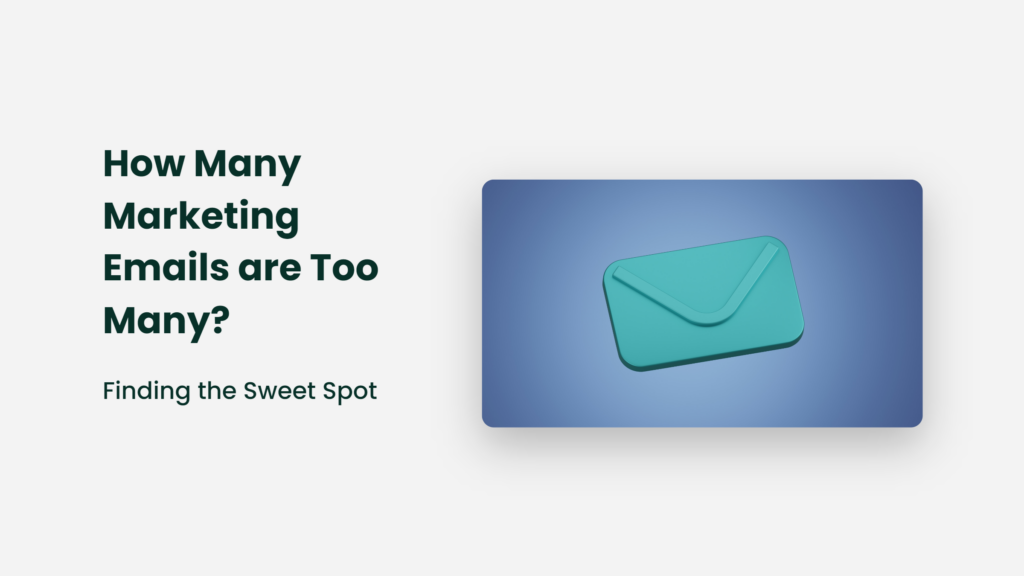How Many Marketing Emails are Too Many? Lets learn about this hot topic by getting an insight about Email marketing. Email marketing is like baking a cake – too much of a good thing can ruin the whole batch! Just like adding too much flour can make a cake dry, sending too many emails can overwhelm subscribers and lead to them unsubscribing.
On the other hand, not sending enough emails is like a cake without enough sugar – it’s just not satisfying! Finding the right email frequency is critical to keeping subscribers engaged without driving them crazy.
So let’s bake up some sweet email campaigns but do what is necessary on the servings!
Email marketing is an essential part of any successful marketing strategy, but it’s crucial to find the right balance in the frequency of emails. So, how many marketing emails are too many? That’s the question we’ll be exploring in this post.
While it’s tempting to send a flood of emails to keep your audience engaged, there’s a fine line between staying top-of-mind and being labelled as spam. We’ll dive into the risks and benefits of different email frequencies, tips, and best practices for finding that sweet spot.
The downsides of sending too many marketing mails

Sending too many marketing mails can be detrimental to the success of your email marketing campaign. Overwhelming subscribers with too many emails can lead to email fatigue, causing them to disengage from your content or even unsubscribe altogether. Moreover, high email frequency increases the risk of unsubscribes.
Keeping valuable subscribers who might have been interested in your products or services in the future can help your email list and impact your bottom line. Additionally, a high volume of emails can also result in spam complaints. If subscribers start marking your emails as spam, it can damage your sender’s reputation and cause your emails to be filtered into spam folders.
It can ultimately reduce your ability to reach your target audience, reducing your email campaign’s effectiveness. Overall, sending too many marketing mails can harm your brand’s reputation and negatively impact the effectiveness of your email campaigns, so it’s essential to find the right balance in email frequency.
Statistics to illustrate the potential adverse effects of over-emailing

Sure, here are a few statistics and examples to show the potential negative impacts of over-emailing:
- According to a study by Marketing Sherpa, 78% of consumers unsubscribe from email lists because the sender is sending too many emails.
- In a survey by Adobe, 40% of respondents said they would unsubscribe from a brand’s email list if they received too many emails.
- One example of the adverse effects of over-emailing comes from clothing retailer J. Crew, who faced backlash from subscribers after increasing their email frequency from one email per week to three emails per day. This led to a significant increase in unsubscribes and complaints.
- Another example comes from the travel booking site Expedia, which sent over 1,000 emails to a customer in a single year, leading to a viral social media post and negative press coverage.
These examples and statistics illustrate the potential adverse effects of over-emailing, including unsubscribes, complaints, and negative publicity. Brands must find the right balance in email frequency to avoid overwhelming their subscribers and risking these adverse outcomes.
How many marketing emails are too many? Finding the right email frequency
Sending the right amount of emails is crucial for maximising email campaign success, as it can lead to better open rates, click-through rates, and overall subscriber engagement. When subscribers receive too many emails, they are more likely to ignore or delete them without opening them, resulting in lower open rates.
This can also decrease click-through rates, as fewer subscribers engage with the email’s content. On the other hand, if subscribers receive more occasional emails, they may forget about your brand or lose interest in your products or services, resulting in low overall engagement.
By finding the right balance in email frequency, however, you can increase your chances of success. When you send the right amount of emails, your subscribers are more likely to be engaged with your content and, therefore, more likely to open and click through your emails.
This can lead to higher conversion rates, better ROI, and stronger customer relationships. Moreover, subscribers receiving high-quality, targeted emails are likelier to remain on your email list and even recommend your brand to others.
Overall, the answer to the question, “how many marketing emails are too many?” is sending the right amount of emails is essential for maintaining strong subscriber engagement and achieving email marketing success. Finding the perfect balance can increase your open, click-through, and overall engagement, resulting in a more effective and efficient email marketing campaign.
Factors to consider when determining “how many marketing emails are too many?”
When deciding how many marketing mails are too many, there are several factors to consider that can impact the email marketing frequency. Here are a few things to keep in mind:
- Industry: Different industries may have different expectations around email frequency. For example, a daily email might be too much for a gardening business but not for a news outlet.
- Target audience: Consider the preferences and habits of your target audience. For instance, a younger audience might be more receptive to frequent emails, while an older audience might prefer less frequent communication.
- Type of content: The content you’re sending can also affect email frequency. For example, monthly newsletters with a roundup of related article(s) might be sent weekly, while a promotion or event announcement might require more frequent emails.
- Seasonality: Depending on your industry, seasonality can impact how often you should send emails. For example, a retailer might send more frequent emails during the holiday season but fewer periodic emails during the summer.
- Email engagement metrics: Pay attention to how subscribers engage with your emails. You can send more frequent emails if you see high open and click-through rates. However, it might be time to scale back if engagement is low.
Considering these factors, you can decide how many marketing emails are too many.
How many marketing emails are too many? Tips to test and adjust email frequency
Businesses can segment their audience and test different frequencies for each group to try and adjust mail frequency effectively. A/B testing can also be conducted to compare results and determine the optimal frequency for the audience.
Encouraging feedback from subscribers through surveys or social media polls can also provide insights into preferences. Managing subscriber expectations by communicating mail frequency can prevent unsubscribes.
Monitoring engagement metrics such as open rates, click-through rates, and unsubscribes is important as adjusting email frequency accordingly. By implementing these tips, businesses can find the sweet spot for mail frequency, leading to better engagement and campaign effectiveness.
Best practices for email frequency
To maximise the effectiveness of email marketing campaigns, companies should follow best practices for mail frequency. This includes finding the right balance for their specific audience and industry, being consistent with the email schedule, segmenting the audience based on location, interests or purchase history, personalising content, and providing value to the subscriber.
Additionally, respecting subscriber preferences by allowing them to manage their email preferences can reduce unsubscribes and improve engagement. By following these best practices, companies can improve concentration, find the right mail frequency for their audience, and achieve better results from their email campaigns.
Examples of companies that have successfully found their optimal email frequency

Several companies have successfully found their optimal email frequency by testing and adjusting over time. For example, the beauty brand Glossier sends just one email per week, delivering focused and tailored content to its audience.
The brand also varies its email content to include new product launches, exclusive offers and customer testimonials. Similarly, music streaming service Spotify found success with a personalised email campaign that sends out a weekly playlist to users. The playlist is customised based on the user’s listening habits, providing value and keeping them engaged with the email service providers.
Finally, online retailer Amazon sends a range of emails with various frequencies based on the user’s purchase history and browsing behaviour. For example, if a user adds items to their cart but doesn’t purchase, Amazon will send a reminder email a few days later to encourage them to complete the purchase.
By tailoring the frequency and content of emails to their audience, these companies have found the sweet spot for email marketing, resulting in high engagement and conversion rates.
Frequently Asked Questions
Q: How can I avoid overwhelming subscribers with too many emails?
A: To avoid overwhelming subscribers, segment your email list based on factors such as location, interests or purchase history. Personalize email content and provide value to subscribers to keep them engaged. It’s also important to communicate mail frequency and allow subscribers to manage their preferences.
Q: Can sending too many emails lead to unsubscribes?
A: Yes, sending too many emails can lead to unsubscribes or even being marked as spam. Subscribers may feel overwhelmed or annoyed with the frequency of emails and decide to opt-out of your email list.
Q: How many digital marketing emails should I send per week?
A: The optimal mail frequency depends on several factors, such as your industry, target audience, and type of content. A general rule of thumb is to send no more than one to two emails per week to avoid overwhelming subscribers.
Final thoughts on “how many marketing emails are too many?”
It’s time to get wild with your mail frequency and experiment like a mad scientist in a laboratory! Feel free to test different frequencies and see what works best for your unique audience and industry.
Your subscribers may need more content and want daily emails or prefer to keep it weekly or monthly. Whatever the case, gathering data and analysing engagement metrics is essential to determine what’s working and what’s not.
And hey, why not share your findings with others? Brag about your excellent results on social media, chat with fellow marketers, or even write a blog post about it. Who knows, you may become the following email marketing superstar!





